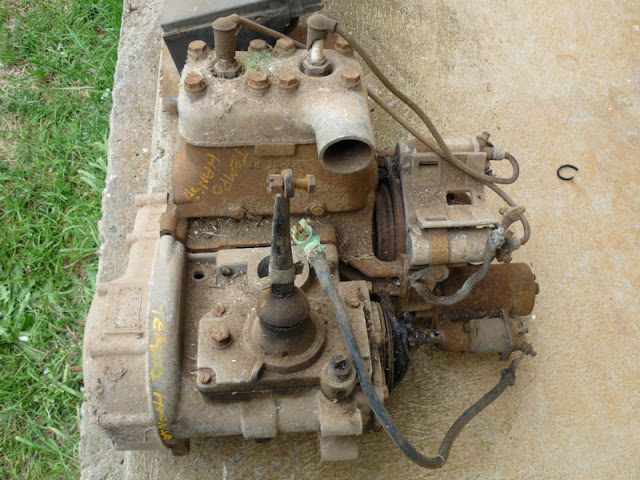
These places had their fair share of car wrecks. Whilst some of my friends found them amusing outlets for their own destructive tendencies, I was obsessed with saving and restoring them. I don't know how many times my parents must have rolled their eyes when I came home and waxed lyrically about salvaging some hopeless wreck. And hopeless they were too; shattered wrecks, smashed beyond repair, some burnt out. But it never mattered to me. They all should be saved. I guess I have always been drawn to the lost causes and hopeless cases.
1952 Tempo Hanseat restoration project
A year or so ago I was trolling through the 'restoration and salvage' pages of Australian eBay. It was not something I would normally look at but there had recently been a Goggomobil Dart project advertised there in error before being quickly withdrawn (or sold). It made me wonder whether other gems may have also been lurking there. Let's face it, many eBay sellers are less than honest in their descriptions. How many times have you seen someone trying to sell a piece of scrap metal in the automotive section, describing it as a "classic, resto, project, rat rod, etc, etc" but in fact it's little more than a total wreck discounted slightly below concourse pricing? Only a couple of weeks ago someone was trying to sell a Tempo Matador rear axle for A$4000. They were complaining that this was the third time that they'd advertised it and there was no interest. Hello? Yes, Tempo Matadors are relatively rare, but it's the rusted remains of a rear axle not the whole damned truck! But I digress....

Anyway, one posting caught my eye: 'Tempo Hanseat engine.' Tempo Hanseat? In Australia? It must be a mistake. The German Vidal and Son company of Hamburg began building Tempo speed tricycles in the 1920s. They were a simple three wheeled truck powered by a small two cylinder JLO proprietary two-stroke engine driving the front wheel via a chain. They could be driven without either a license or registration and were immensely popular and remained in production until 1956. But they were never officially imported into Australia.


I contacted the seller and he provided me some brief details about the parts he had but after the initial contact I let it pass. I had too many other things going on and really what was I going to with a Tempo engine?

Fast forward 18 months and I'm trolling through my emails and come across the Tempo engine correspondence. Out of interest I email the seller and he confirms he still has the engine if I want it. What's more, he's located more of the vehicle and he has an interesting tale to tell about its unlikely providence.

The Tempo was bought out to Australia by a French emigre in the mid-1950s (the Tempo was built around 1952). He settled in Blackheath in the Blue Mountains, east of Sydney and used the Tempo as a farm and delivery vehicle for a number of years. The steep and hilly landscape of the Blue Mountains wasn't exactly the best environment for the Tempo, which easily became unbalanced when unloaded. The seller remembers seeing the Tempo tipped over on its nose on the roadside as a kid.

After a number of years and a couple of accidents the owner decided to sell the Tempo but there were no takers for such an eccentric vehicle so he ended up selling it to a wrecker in Katoomba in the 1960s. The wrecker stripped the vehicle of those mechanical parts that could potentially be reused - the engine, radiator, drive, petrol tank - and stored them for later. The cab was sawn from its tube chassis and tray, which was converted into a trailer and sold. The cab was scrapped.

Conversion into a trailer was a fairly common fate of many old Tempos. Their simple construction made the conversion process fairly straightforward - cut the tube chassis under the cab and you're basically done. This example from German eBay in April 2012 is from a 1954 Tempo.
So what remains? Basically only the engine, starter motor, clutch, gearbox, radiator, drive-train, steering, and petrol tank, which the wrecker had put aside when he stripped the vehicle. He'd thought he might have used the radiator in a Model T Ford restoration he was working on, but it didn't work out so he put it and the other parts aside, where they were forgotten and, by accident preserved. The tray, tube chassis, rear axle and wheels might still be out there. I'll start inquiries but I don't hold out much hope of ever finding it. The cab of course is long gone. As a project, this really is a 'Hail Mary!' It has almost no hope of success, but for some reason I find myself inclined to try. The Tempo was a very basic machine. The chassis is a bare tube. I think I could find a cab in India or at the very least recreate one in fibre-glass or wood (like a pre-war DKW). Who knows? Sometimes its about the journey not the destination.

Progress of the projects can be found here in my Tempo Blog: http://tempohanseat.blogspot.com/
I like the Tempo Hanseat, but its stability would be less critical if it had a longer wheelbase combined to a shorter rear overhang, improving the weight balance even when loaded. I still consider to make a replica from scratch just for fun, altough finding a more modern engine suitable to such project doesn't seem to be an easy task.
ReplyDelete